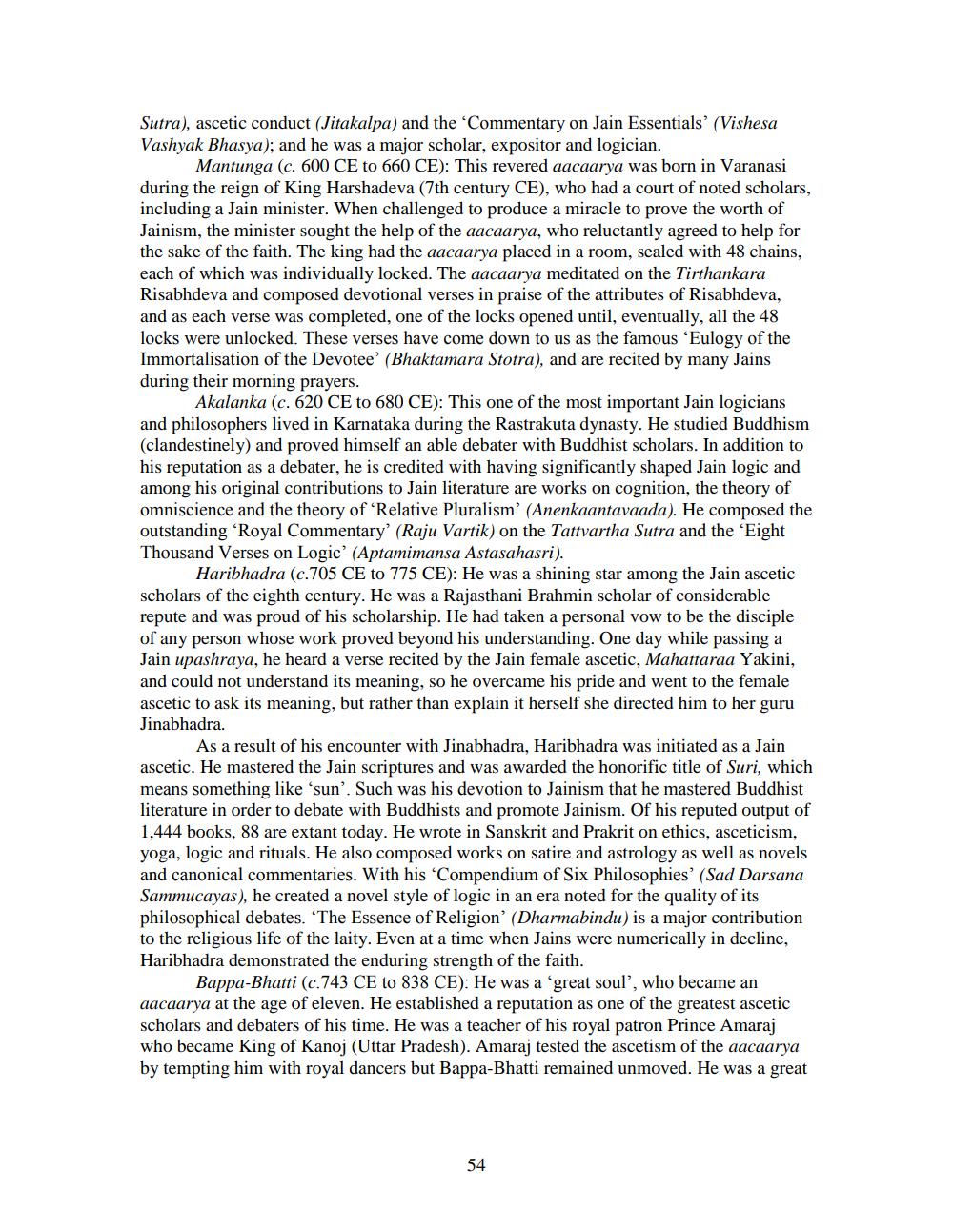________________
Sutra), ascetic conduct (Jitakalpa) and the 'Commentary on Jain Essentials' (Vishesa Vashyak Bhasya); and he was a major scholar, expositor and logician.
Mantunga (c. 600 CE to 660 CE): This revered aacaarya was born in Varanasi during the reign of King Harshadeva (7th century CE), who had a court of noted scholars, including a Jain minister. When challenged to produce a miracle to prove the worth of Jainism, the minister sought the help of the aacaarya, who reluctantly agreed to help for the sake of the faith. The king had the aacaarya placed in a room, sealed with 48 chains, each of which was individually locked. The aacaarya meditated on the Tirthankara Risabhdeva and composed devotional verses in praise of the attributes of Risabhdeva, and as each verse was completed, one of the locks opened until, eventually, all the 48 locks were unlocked. These verses have come down to us as the famous 'Eulogy of the Immortalisation of the Devotee' (Bhaktamara Stotra), and are recited by many Jains during their morning prayers.
Akalanka (c. 620 CE to 680 CE): This one of the most important Jain logicians and philosophers lived in Karnataka during the Rastrakuta dynasty. He studied Buddhism (clandestinely) and proved himself an able debater with Buddhist scholars. In addition to his reputation as a debater, he is credited with having significantly shaped Jain logic and among his original contributions to Jain literature are works on cognition, the theory of omniscience and the theory of 'Relative Pluralism' (Anenkaantavaada). He composed the outstanding "Royal Commentary' (Raju Vartik) on the Tattvartha Sutra and the "Eight Thousand Verses on Logic' (Aptamimansa Astasahasri).
Haribhadra (c.705 CE to 775 CE): He was a shining star among the Jain ascetic scholars of the eighth century. He was a Rajasthani Brahmin scholar of considerable repute and was proud of his scholarship. He had taken a personal vow to be the disciple of any person whose work proved beyond his understanding. One day while passing a Jain upashraya, he heard a verse recited by the Jain female ascetic, Mahattaraa Yakini, and could not understand its meaning, so he overcame his pride and went to the female ascetic to ask its meaning, but rather than explain it herself she directed him to her guru Jinabhadra.
As a result of his encounter with Jinabhadra, Haribhadra was initiated as a Jain ascetic. He mastered the Jain scriptures and was awarded the honorific title of Suri, which means something like 'sun'. Such was his devotion to Jainism that he mastered Buddhist literature in order to debate with Buddhists and promote Jainism. Of his reputed output of 1,444 books, 88 are extant today. He wrote in Sanskrit and Prakrit on ethics, asceticism, yoga, logic and rituals. He also composed works on satire and astrology as well as novels and canonical commentaries. With his 'Compendium of Six Philosophies' (Sad Darsana Sammucayas), he created a novel style of logic in an era noted for the quality of its philosophical debates. The Essence of Religion' (Dharmabindu) is a major contribution to the religious life of the laity. Even at a time when Jains were numerically in decline, Haribhadra demonstrated the enduring strength of the faith.
Bappa-Bhatti (c.743 CE to 838 CE): He was a 'great soul', who became an aacaarya at the age of eleven. He established a reputation as one of the greatest ascetic scholars and debaters of his time. He was a teacher of his royal patron Prince Amaraj who became King of Kanoj (Uttar Pradesh). Amaraj tested the ascetism of the aacaarya by tempting him with royal dancers but Bappa-Bhatti remained unmoved. He was a great
54




